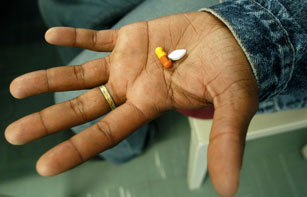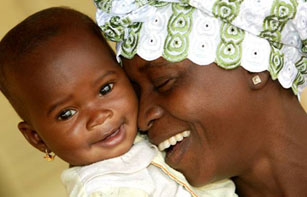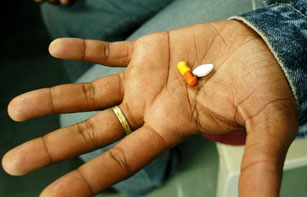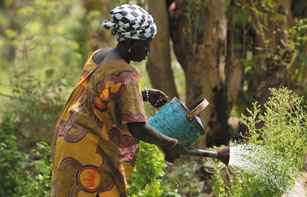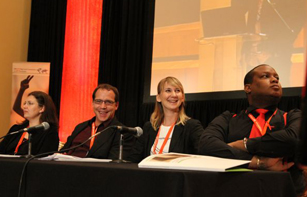
Panel on Social media and HIV prevention from left: Ms Helen Alexander, Sonke Gender Justice Network, Mr Richard Delate, The Johns Hopkins Health and Education in South Africa, Olga Rudnieva, Elena Pinchuk ANTIAIDS Foundation and Mr Ian Royer, What about HIV? Campaign. 2 May 2011.
Credit: Stefan Els, Stellenbosch University.
With more than 7 000 people newly infected with HIV everyday and 1 000 of these new infections occurring in South Africa, Stellenbosch University just outside Cape Town, was the ideal setting of a high level panel discussion on how social media and mobile technology has been and can be leveraged to prevent new HIV infections.
“The potential of new technologies to re-energize the AIDS-movement is clear. We need nothing less than an HIV prevention revolution, with social media and mobile technology at its core,” said Michel Sidibé, Executive Director of UNAIDS in his opening remarks.
Two panels one—on social media one on mobile technology—were livestreamed via the UNAIDS page on Facebook. The discussions brought together technology leaders, AIDS activists, and social media experts to share ideas of how these new tools can be integrated as part and parcel of HIV prevention programmes.
Mobilizing social networks for HIV and young people
During the social media session, a work in progress project was presented by Mr Ian Royer, a delegate at the recent Global Youth Summit on HIV in Mali. Participants at the summit launched a collaborative social media campaign together with an outcome document aimed at mobilizing youth organizations and networks globally to endorse the summit’s call to action. The website www.whatabouthiv.org is the hub of this initiative.
“So far we have had more than 1 000 endorsements and engaged more than 7 000 people from all around the world. Social media is an ideal tool to mobilize young people,” said Mr Royer. “We are scaling up our effort in the lead up to the High Level Meeting on AIDS in June to make sure that our call to action is heard loud and clear!”
With social media being all about two way conversations, the panelists took questions from Twitter and Facebook posed by people following the discussion online. Tweeter @baruchdom made the following comment: “Remember that the majority of Sex Workers and Drug Users and trans people don't have access to internet or social networking.”
A reply came from panelist Helen Alexander, with the Sonke Gender Justice Network: “In South Africa at least, the cell phone is an important tool of the trade for sex workers, as it helps them connect to their clients, and helps to keep them safe. So mobile phones are actually a great way to reach sex workers. It’s anonymous, you don’t have to track people down, and often these are people who are not comfortable coming to a community event,” said Ms Alexander.
Mobile platforms for social change
There are 500 million cell phones in Africa, and mHealth or mobile health is increasingly recognized as an effective channel for HIV programming.
We need nothing less than an HIV prevention revolution, with social media and mobile technology at its core
Michel Sidibé, UNAIDS Executive Director
“How can we begin to maximize the use of mobile technology for HIV prevention?” asked Marlon Parker Founder of Reconstructed Living Lab, a South African social enterprise. “We have to use this technology to educate, engage and empower people—and we can take this beyond the platforms to offline action!”
Ms Debbie Rogers, Lead Strategist of Praekelt Foundation, shared lessons learned from their free mobile platform Young Africa Live, which among other things aims to prevent new HIV infections in South Africa. According to Ms Rogers, the platform has reached 32 million page views and more than 950,000 comments posted since its launch.
App-development competition for HIV prevention launched
The internet and social media are widely used by young people everywhere—including low income countries. These tools have the potential to deliver HIV prevention programmes in a cost-effective way to young people through a media that they are already using.
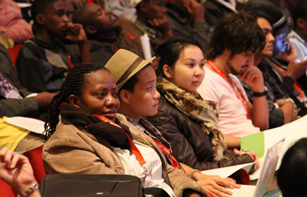
Participants at the social media and mobile technology for HIV prevention hosted at the Stellenbosch University, South Africa. 2 May, 2011.
Credit: Stefan Els, Stellenbosch University.
To move forward this agenda, Ms Olga Rudnieva, Executive Director, Elena Pinchuk ANTIAIDS Foundation, closed the event by announcing a competition for developing social media and/mobile applications for HIV prevention.
"By the end of the next week the criteria will be on the UNAIDS website. The challenge is to come up with a social network project with or without mobile applications to prevent HIV. We are welcoming projects up to USD 10 000. You have to be creative, innovative, do something good for you and for your community!” said Ms Rudnieva.
In the lead up to the High Level Meeting on AIDS, the social media and mobile technology for HIV prevention panels were co-hosted by UNAIDS and Stellenbosch University. It is part of UNAIDS strategy to inspire and catalyze young people to use social media to ignite an HIV prevention revolution.











